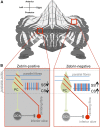All Purkinje cells are not created equal
- PMID: 24916160
- PMCID: PMC4049172
- DOI: 10.7554/eLife.03285
All Purkinje cells are not created equal
Abstract
Although the wiring of the cerebellar cortex appears to be uniform, the neurons in this region of the brain behave more differently from each other than previously thought.
Keywords: Purkinje cells; TRPC3; cerebellar modules; cerebellum; neural circuits; zebrin II.
Copyright © 2014, Albergaria and Carey.
Conflict of interest statement
Figures

Comment on
-
Cerebellar modules operate at different frequencies.Elife. 2014 May 7;3:e02536. doi: 10.7554/eLife.02536. Elife. 2014. PMID: 24843004 Free PMC article.
References
-
- Bloedel JR. 1992. Functional heterogeneity with structural homogeneity: how does the cerebellum operate? Behavioral and Brain Sciences 15:666–678. doi: 10.1017/S0140525X00068862 - DOI
Publication types
MeSH terms
LinkOut - more resources
Full Text Sources
Other Literature Sources

